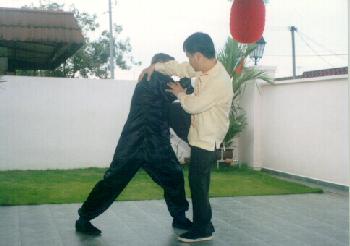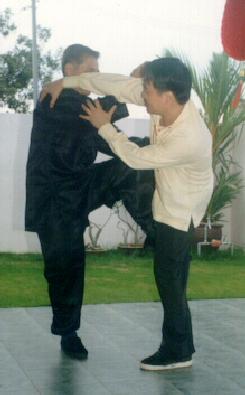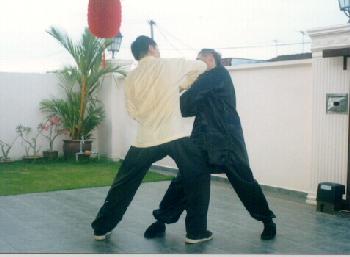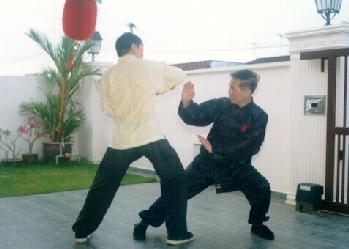May 2000 (Part 2)
SELECTION OF QUESTIONS AND ANSWERS

Sifu Goh Kok Hin clinches Grandmaster Wong's neck and executes a knee attack to his chest in a pattern called “Jade Girl Kicks Shuttle” in Shaolin Kungfu, which is similar to knee strikes in Muai Thai or Siamese Boxing
Question 1
One of the most popular martial arts of our time is the so-called Ultimate Fighting. Compared to other contact martial arts/sports there are only a couple of rules (no attacks aimed at the eyes, no tearing of the mouth, the ears and the nose, no bitting). Other techniques are allowed (even attacks aimed at the groin, for example). No protection gear (except the mouth guard and the jockstrap), so no boxing gloves.
— Pavel, Czech Republic
Answer
The inventors of this style of martial art tried to be as near as possible to actual fighting while providing some safety precautions for competitions as sports. This is actually what happens in kungfu, including Taijiquan, except that kungfu is not meant for sports, and was evolved by thousands of people in real fighting over many centuries, not invented by a few persons recently. In other words, one performs kungfu movements exactly the way he would use them in a real fight.
Question 2
I carefully watched various fights and I have noticed what kind of techniques the fighters use. I think a lot of people from the Western world notice the fighting efficiency of these arts and think these arts are superior to traditional Chinese martial arts.
Answer
These arts are effective, probably more effective for real fighting than many modern martial arts. This is mainly because these arts are geared towards and practised for fighting, whereas modern martial arts are geared towards and practised more for sports.
In judo, for example, you cannot jab your fingers into an opponent's eyes although there are actually many opportunities to do so during a typical judo match. In taedwondo you cannot move in and strike the opponent's groins. These modern martial arts or sports are seriously limited in real combat by their own safety rules, but it is only sensible to have these rules if we practise them as sports.
Today, there are actually very few people practising genuine traditional Chinese martial arts — not even in China, where modern wushu, which is actually a sport, and not kungfu is the norm. Those who practise wushu and those who practise kungfu as sports (where much of the time is spent in performing solo sets), are no match at all against exponents of these fighting arts. But the situation will be different when exponents of these arts meet genuine kungfu masters. Personally I think genuine kungfu masters will win.

Grandmaster Wong lifts his arms to disengage Sifu Goh Kok Hin's clinch, and lifts up a knee to deflect the knee strike. In Shaolin Kungfu this pattern is called “Strumming Lute on Single Leg”, and in Taijiquan “Golden Cockerel Stands Alone”.
Question 3
The way the practitioners of these arts prove their efficiency in fighting is simple — they use their techniques in fighting. Compared to other contact sports, ultimate fighting is quite close to real fighting, in spite of the few rules I have mentioned above. I think the readers of your pages will appreciate your point of view.
Answer
Yes, you are right. The main reason why these arts are superior is that not only they are constructed for fighting, they are also practised for fighting. In comparison, modern martial arts are constructed and practised for sports.
In this respect kungfu and these fighting arts are similar — both are for fighting, not sports. But kungfu has a big advantage. It has a history of many centuries, which means that kungfu techniques, skills and principles have evolved and been perfected for many centuries.
Only the best and proven techniques, skills and principles have been preserved and passed down to us as a legacy, whereas these fighting arts were invented only recently, as a reaction against the inefficiency of many modern martial arts for fighting.
In other words a kungfu master has a huge and rich repertoire for fighting purposes. One with Iron Palm, for example, may kill or maim an opponent with just one strike, whereas an exponent of these arts may need many punches.
Question 4
I would like to ask you as a world-known Sifu, if you would be so nice as to share with us your opinion on how to avoid and counter some of these techniques. How to avoid and counter Thai-boxing low-kicks (Tornado/Whirlwind kicks in kungfu), aimed at the thigh — not at the waist or the head, as shown in one of your valuable pages dedicated to fighting, explaining how to counter middle Thai-boxing roundhouse kicks.
Answer
If you are at a Bow-Arrow Stance, withdraw your front leg to a False-Leg Stance, if you are at a False-Leg Stance, withdraw your “false” leg backward to a Bow-Arrow Stance, and jab your leopard punch at the ankle of the kicking leg.
Thai-Boxing exponents are very good at feign movements; they may pretend to kick with one leg but actually kick with the other leg. Nevertheless, in this case it does not matter which leg he uses for kicking. But you must be careful that he may jump in with an elbow strike. If he does so, move your body slightly backward, deflect his elbow strike and simultaneously jab a leopard punch into his ribs.

Sifu Goh Kok Hin moves in to attack Grandmaster Wong's face with a high elbow strike, which is common in Muai Thai, and is called “Crow Flaps Wings” in Shaolin Kungfu
Question 5
How to avoid and counter Thai-boxing knee kicks and elbow punches, in so-called clinch (both hands usually wrapped around the opponent's head, fighters being very close to each other).
Answer
If he uses his right knee to strike you, move your right leg diagonally forward to your right. At the same time use your right hand to deflect his elbow strike and place your left palm against his jaw from below.
Immediately place your left leg behind his lone standing leg and push hard with your left hand at his jaw to fell him to the ground. If you drop your body weight on him and hit his ribs with your knee, you could break his rib case, puncture his lungs and kill him. So take care not to do that.
Instead, manoeuvre him so that he lies on his left side, step your right foot on his two arms, squat on his right leg with your left knee so that he cannot kick you, and place your right thumb and right index finger at his throat to hold him under control. You still have your left hand free to do whatever you wish.
Question 6
How to avoid and counter different wrestling techniques? I mean not to allow the opponent to take you to the ground.
Answer
Wrestling is a sport, and is not advisable in real fighting. If a wrestler were to go low and attempt to grasp the legs of a kungfu master, the master would bring one leg backward to a low Bow-Arrow Stance and strike the crown of the wrestler's head, killing the latter with just one blow. Alternatively the kungfu master could execute a palm strike to the wrestler's back, injuring him seriously.
The wrestling matches we see on TV are faked. Notice that each time a wrestler drops onto his opponent, he always supports his weight on his own leg, merely touching the opponent with his elbow or another part of his body, but giving an impression to uninitiated spectators that he is dropping his whole weight on his opponent.
There is a counter for every hold and lock a wrestler shows on TV. Wrestlers are professional fighters; it is unlikely that they do not know these counters. But they do not apply them because they are putting up a show to entertain spectators.
In China during the Song and Yuan Dynasties more than 500 years ago, wrestling was a popular sport. It was known as shuai jiao.
Question 7
How to avoid and counter Jiu-jitsu techniques on the ground, with the defender lying on his back, and the attacker kneeling, being on the top of the defender, throwing punches at him. It seems to be quite a helpless position for the defender.
Answer
As he strikes you, use your left hand to push his left arm at his elbow to his right so that his body is turned to his right too and he could not effectively use either hand to strike you. Simultaneously strike a leopard punch at a soft spot just below his exposed left ribs. Just one strike would cause so much pain that he would roll over.
If he uses his both knees to squat on your both arms, which means you cannot use your hands and he is sitting on your chest. Bend your left knee, and swing your right leg upward, around and at his neck to fell him backward.

Grandmaster Wong moves his back leg a small step backwards and simultaneously deflects Sifu Goh Kok Hin's elbow attack with his right hand
Question 8
How to avoid and counter Jiu-jitsu techniques on the ground with the defender lying on his belly, the attacker behind him and choking him with both arms (arms together, choking him with his forearm). I have seen many fighters win with this technique.
Answer
Grip a finger of the choking arm and dislocate it. Jab backward with the other palm, at his throat if possible. As the opponent loses his concentration while in pain, move up onto your knees and hands and throw him off your back.
Question 9
How to avoid and counter other techniques, especially joint-locks, choking techniques, elbow and knee punches on the ground. I know you have vast knowledge of different techniques and strategies of Shaolin Kungfu. Are there any similar techniques and counters in Shaolin Kungfu? Can you please recommend some useful strategies when fighting grappler/wrestlers? What do you think about ground fighting in kungfu, please?
Answer
The counters against these attacks are similar whether you are standing or on the floor. In kungfu, Shaolin or otherwise, we avoid fighting on the ground because there are more advantages standing on our stances. If we are felled to the ground, we roll away (like a ball) and spring up. But sometimes a kungfu exponent may pretend to fall onto the ground to trick his opponent. The style of kungfu called “Di Dang Men”, or Floor Kungfu, specializes on floor techniques.
If your stances and footwork are good, it is difficult for a wrestler or any fighter to get you to the floor. If a wrestler attempts to grab your leg, you bring the other leg backward to a low Bow-Arrow Stance and strike you elbow hard downward onto his shoulder blade or collar bone.
If he manages to grab both your legs, lean forward and fall onto his back. Simultaneously jab both palms into the soft spots on both sides beneath his rib cage. The severe pain will cause him to release his grips. If you are still standing on the ground, lift up one knee to strike his face. If you are already fallen on the floor, execute a thrust kick (with your heel) on his ribs before rolling away.
Wrestling and ground fighting are little used in kungfu because they are disadvantageous to the exponent. To wrestle, you normally have to use your hands to grapple with your opponent, which means you indispose them for defence. And at such close range it is easy for the opponent to strike your vital spots. In ground fighting, you indispose your stances and footwork, which are hallmarks of a good kungfu exponent.
When a kungfu exponent uses ground fighting, as in Di Dang Men, he does not want his opponent on the floor; he wants his opponent to be standing! He himself gets onto the floor because this makes it difficult for his opponent to attack him, while he uses his legs to attack his opponent.
Question 10
I have been studying Wing Chun for about 20 months and it is quite surprising how many different styles appeared from the same set of ideas.
— Jonathan, USA
Answer
Such developments, which were usually made in response to practical needs, enrich the repertoire of kungfu. If we consider that kungfu has a continuous history of a few thousand years and has been practised in a region where one out of every four persons in the world lives, we can imagine how huge and rich this repertoire is, especially when compared with martial systems recently invented by a few dis-satisfied martial artists and practised by a limited number of persons.
Wing Chun Kungfu was developed by a lady kungfu master called Yim Wing Chun about 150 years ago. She practised Shaolin Kungfu, which already had about 1500 years of history behind it. Hence, strictly speaking, she did not invent Wing Chun Kungfu, rather she selected from what she had learnt those techniques and skills that suited her particular needs and improved them.
As a woman wearing long skirts at that time, she found wide stances and various Shaolin kicks unsuitable. As she was relatively not as strong as male martial artists, she preferred straight attacks at opponents' vital spots, and discarded techniques like felling and locking which are more advantageous to bigger-sized persons.

Grandmaster Wong immediately moves his body forward, without moving his legs, “floats” Sifu Goh Kok Hin's arm with his right hand and simultaneously strikes Sifu Goh's ribs with his left palm. This pattern is known as “Double Bows Tame Tiger” in Shaolin Kungfu, and “Jade Girl Threads Shuttle” in Taijiquan.
Question 11
One thing that confuses me is the internal energy aspect. Some people say by practising the forms you develop qi while others say that there aren't any qi aspects in Wing Chun.
Answer
Both statements are correct. The apparent contradiction is due to the limitation of words in expressing exactly what the speakers wanted to say, and also because their statements were made with reference to their particular situations only.
Let us take the first factor — apparent contradiction due to the limitation of words. And let us take a typical Wing Chun form — the cup fist, also called the sun-character fist as it resemblers the Chinese character for “sun”. A skilful Wing Chun exponent may perform the form as follows.
He sits at the Goat Stance. He places his left fist at his side at the level of his left breast, and his right cup fist in front of his chest. He takes a deep breath gently into his abdomen. Then he moves his right cup fist slowly forward, simultaneously directing his qi to flow from his abdomen to his tersed right arm and generating the qi into internal force. After three repetitions, he thrusts out his cup fist fast. Here, by performing this form the exponent develops qi.
A Taijiquan exponent observing the performance may exclaim, “No, that is not qi! We may call it 'jing', but we don't call that qi.” This Taijiquan exponent is quite right if we accept his concept, which is fundamental in Taijiquan, that to develop qi one has to relax totally; one cannot terse his arm. In fact, the internal force the Wing Chun exponent will develop from that training is known as “jun jing”, or Inch-Force.
Let us, for comparison, see how the Taijiquan exponent would practise his typical “peng” form to develop qi. Like the Wing Chun exponent, he takes a deep breath gently into his abdomen. Then he moves to a right Bow-Arrow Stance and moves his right arm slowly and gently out from near his left waist to a short distance at his right eye level. Simultaneously he directs his qi to flow from his abdomen along his right arm to his right finger tips.
In his movement he is totally relaxed. If he were to terse his right arm, like what the Wing Chun exponent did, he would have stopped his qi flow. He repeats this movement a few hundred times. If he trains sufficiently he would have developed tremendous internal force, and without exerting any muscular tension could cause serious injury with just one strike.
Now let us take the second factor — apparent contradiction due to different situations. A second Wing Chun exponent, but one who has learnt from a mediocre instructor, practises the cup fist in a similar way the first skilful Wing Chun exponent did.
But he does not pay any attention to his breathing, and does not know anything about directing qi flow. He may perform the physical form well and with much muscular strength, but if his practice is representative of what his class does, one is correct in saying there aren't any qi aspects in his Wing Chun class.
Similarly, a Taiji student, who has learnt from an instructor who teaches Taiji dance instead of genuine Taijiquan, may perform the “peng” form in a similar way the Taijiquan exponent did, but without paying attention to breathing and directing qi flow. With sufficient training, he may be elegant and poise, as a dancer usually is, but he is unlikely to develop the kind of internal force that can fell an opponent with one strike. One is correct in saying there aren't any qi aspects in his Taiji form practice.
Question 12
Previously in your reply to a letter you mentioned that qi can't be obtained by just performing the movements.
Answer
I cannot remember that statement, but it was made for the situation in question. Given a different situation, something else may apply. For example, the Taiji student above could not develop qi by performing dance-like Taiji movements, but if he could convert his Taiji dance to genuine Taijiquan, similar movements could produce much qi.
Question 13
Is there any way that I could learn the qi development aspect of Wing Chun? The Wing Chun schools that I know of in my area don't focus on the qi aspect.
Answer
Certainly, learn it from a master who has the qi development aspect of Wing Chun and who is willing to teach you. This is the time-honoured way.
Masters (who already have mastered their arts) may be able to develop new aspects of their arts by learning from books, especially classical texts, or from observing other masters. But virtually all students who had no prior experience of what they desired to learn, but who later succeeded in acquiring the desired skills, did so via the time-honoured way.
It is only moderners, especially in the West, who mistake kungfu gymnastics and chi kung dance for genuine kungfu and genuine chi kung, and who mistake leisure kungfu reading for dedicated kungfu training, who think they can easily learn internal arts by merely reading the relevant training techniques. It is like thinking they can become surgeons by reading surgery text books.
One effective method to acquire the famous Wing Chun Inch-Force is described above. Even if you follow my instructions carefully but train on your own without a master's personal guidance, not only you are unlikely to acquire the force, you are also likely to acquire some internal injury.
Question 14
I've heard of iron darts being used as a weapon in Wing Chun by Sifu Yuen Kay San. But I haven't heard of any teachers that teach it nowadays. Do you know of any?
Answer
My sigong (sifu's teacher) was an expert at “kam chien piu”, or coin-darts. My sifu did not teach me the coin-darts personally, but told me the training method. I practised for some time, but did not continue for I did not find this art practical.
Question 15
I'm about to start qi gong classes this Sunday. I asked the receptionist what style of qi gong the teacher taught, and she replied that he taught a mixture of things, such as the yi jin jin, zhan zhuang and several others. Is there any problems with learning selectively?
Answer
If you want good result, you have to learn selectively. To be good at one qigong style is daunting enough; to think that you can be good at several is usually an indication you will end up being good at nothing.
I may be mistaken but my opinion is that when a teacher teaches many styles of qigong or kungfu, it means he himself has not practised any one style well. He probably reads up about the various styles and teaches them as physical exercise.
